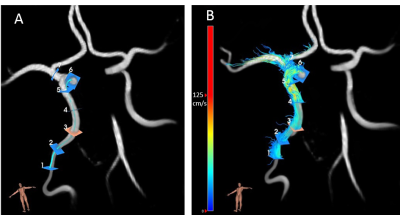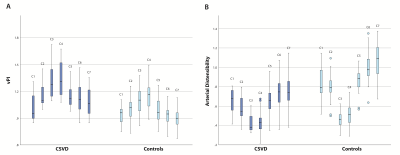Rick J. van Tuijl1, Ynte M. Ruigrok2, Irene C. van der Schaaf1, Lennart J. Geurts1, Gabriël J. E. Rinkel2, Birgitta K. Velthuis1, and Jaco J. M. Zwanenburg1
1Radiology, UMC Utrecht, Utrecht, Netherlands, 2Neurology, UMC Utrecht, Utrecht, Netherlands
1Radiology, UMC Utrecht, Utrecht, Netherlands, 2Neurology, UMC Utrecht, Utrecht, Netherlands
Internal carotid artery calcifications
yield lower arterial distensibility and higher blood-flow pulsatility in
patients with cerebral small vessel disease. Moreover, pulsatility increases
over the siphon in patients, but decreases in controls.

Figure 1: 4D
PC MRA visualization of a subject participating in this study using the CAAS
software (Pie Medical Imaging). A) Based on the fully automated centerline
detection, cross-sections through the different Internal Carotid Artery (ICA)
segments, C1-C7,were selected as illustrated by the 7 slices, with matching
numbers from 1 till 7. B) Visualized streamlines through the selected planes.

